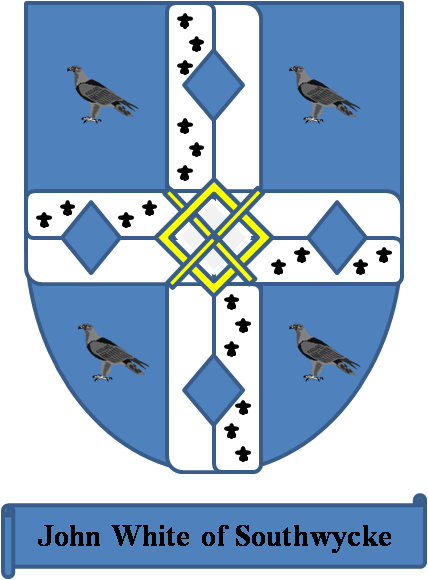 |
Rev John White MA (1574/5-1648)(Also spelt Whyte or Whight)
©Compiled by Michael Russell OPC for Fordington February 2009 |
 |
| Note:- In writing this short biography I have relied heavily upon the following three accounts of his life and events of the day as they are clearly well researched, held in high repute, based largely on established fact and contain clear source material. Other source material used is given in the genealogical notes at the end. Many claims of association with the family or descent from John White himself are either unsubstantiated or clearly wrong. A classic example is the miss-reading of his will which I have transcribed and commented upon separately. Rose Troup also comments upon these claims in her book about his life on pages 392/3. There were many John White's living at this time and I have written a separate account of the life of John White (1590-1645) the parliamentarian who worked with him and was no relation at all. Here I am concerned about the reverend himself and have not therefore gone beyond the clear facts known about his four sons. There are so many John White's in his own family that for the sake of clarity I have from time to time referred to the Rev John White born 1575 as 'John the Patriarch', his son as 'John White junior' and his father as 'John White senior'. 'Fire From Heaven' by David Underdown published by Pimlico 2003 ' William Whiteway of Dorchester' His diary 1618-1635' published by the Dorset record Society in 1991 |
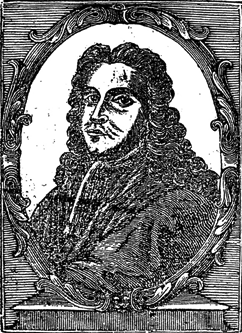 Rev. John WHITE (1574/5-1648), depiction(27) during the Westminster Assembly of Divines 1643/46 John White (1574/5-1648) a puritan divine, and often called the "Patriarch of Dorchester", was baptised (1) at Stanton St John in Oxfordshire on the 6th January 1574/5. He was the second son of six children of John White senior (1550-1618) by his wife Isabel Bawle (1552-1601). He had been born towards the end of December in the two storey Rectory Farm House (39) which was situated just across the street from the 12th Century parish church of St John The Baptist (2) which lies 5 miles north-east by east of Oxford. |
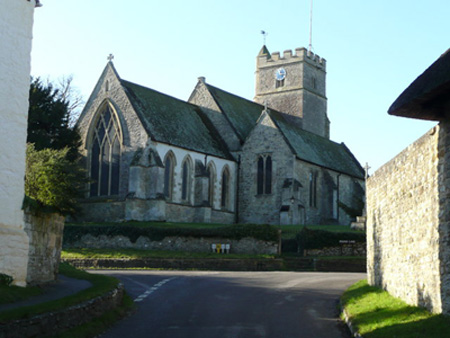 © Jonathan Billinger |
Stanton St John The structure of this grade I listed church, including many of the windows, has survived virtually intact from when John White the Patriarch was baptised there on 6th Jan 1574/5. Dating from the 12th century all but two Corinthian Columns between the nave and chancel date from before the 16th century. Church furniture includes four early 16th Century benches whose 8 bench ends have unusual carvings of poppy heads, human heads and grotesque animals. Evidence of St John's link with New College Oxford is through the crest carved in the 17th Century Jacobean pulpit and set into a window in the chancel. |
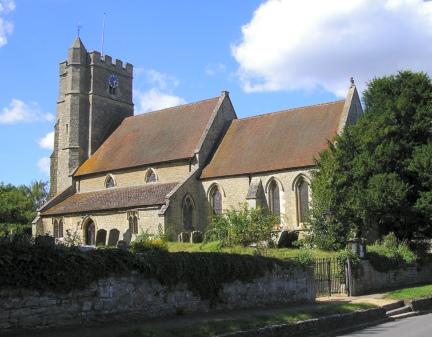 © Jonathan Billinger |
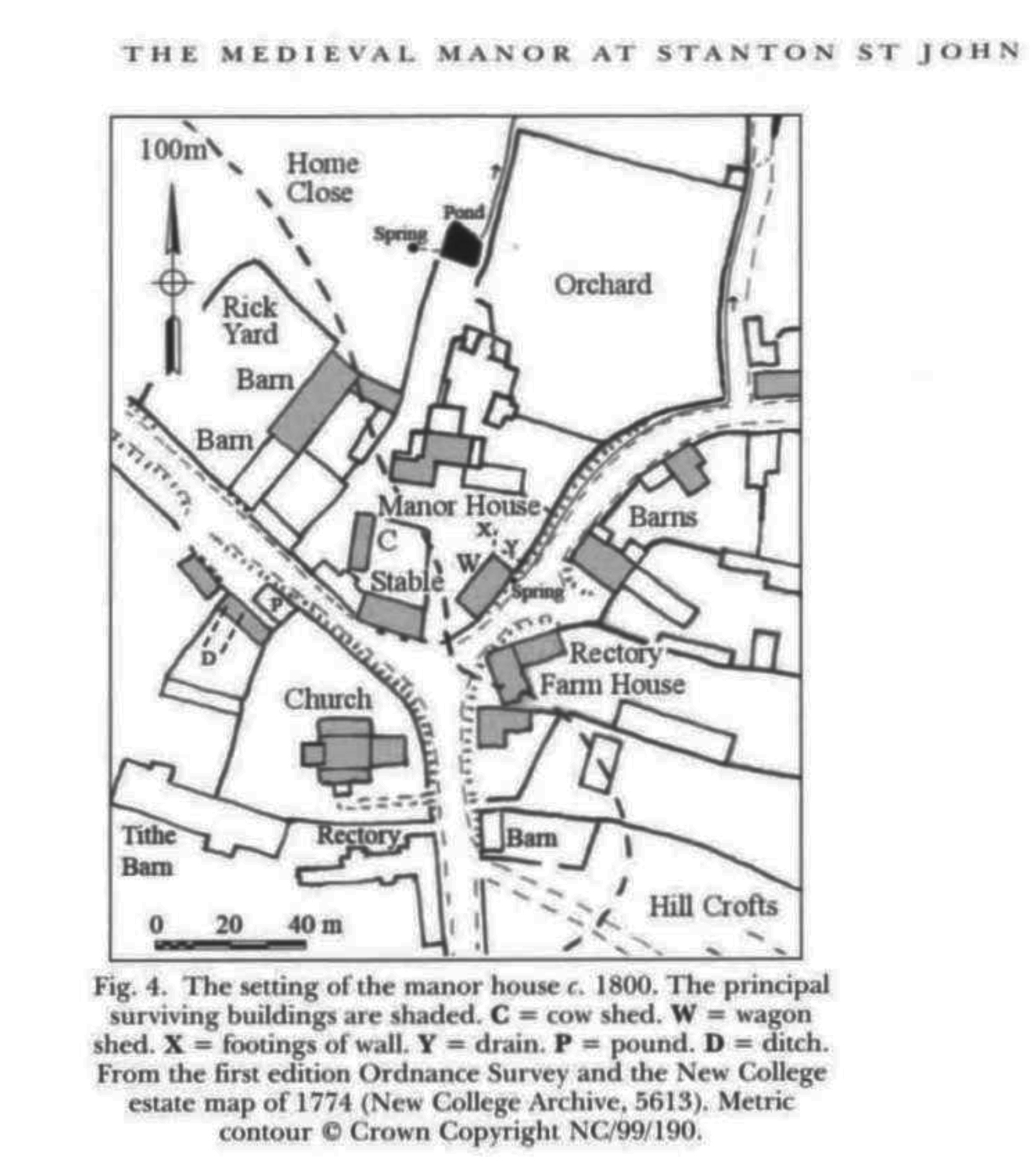
The Manor of Stanton St John was granted to the Warden and Scholars of New College Oxford in 1526, and his great uncle, Thomas WHITE DCL(1514-1588) (17, 20) obtained his doctorate and was appointed warden there in 1553. He was ordained as an acolyte & subdeacon on the same day (8th Sep 1554) and was officially appointed as Rector of Stanton St John on the 10th of the same month. Things moved on quickly with ordination as a deacon on 1st October and priest on 23 December 1554. He was suspected of favouring the 'Old Faith' but continued in office as Warden of New College under Queen Elizabeth (crowned 1559) who liked him. When she visited Oxford (1566) he was one of those who held a canopy over her head on her entry into the Cathedral. Rose Troup in her biography states that in 1561 Thomas granted the lease of Manor Farm, with its outbuildings and associated lands to his nephew, John White senior (1550-1618) the father of our Patriarch. Later research however (based largely on the New College Lease Books) suggests that in 1561 there was still a sitting tenant in Manor Farm and the lease appears to have been that of Rectory Farm situated east of the Church in the above diagram (39) The living of the parish was held according to custom by the Warden of New College 'pro tempore' and hence Dr Thomas Whyte himself would at times have lived in the old rectory. This has since been destroyed, but is shown on the above map immediately south of the church. During the Bishop's visitation of 1566 Thomas faced some serious charges over misconduct and one of these involved 'alienation of College property'. He managed to clear himself however as he remained warden there and Rector of Stanton St John until he resigned both posts in 1574 (38) to concentrate upon his role as chancellor of Salisbury Cathedral where he was later to be buried on 12 Jun 1588. 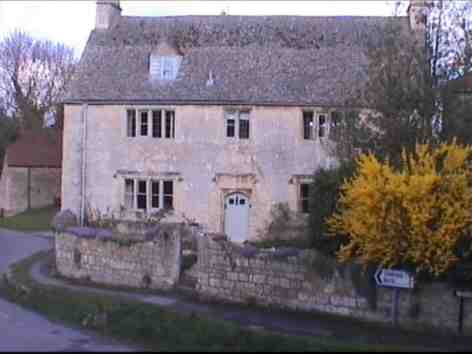 Rectory Farm House - Stanton St John
"Much of College education consisted of listening to famous, and not so famous, lecturers and preachers, and debating their theories. Long, learned treatises were written. By the time John White entered New College it was beginning to lose its reputation as a "nest of crypto-papists". It was here that he really came under the influence of puritan thinking. Due to the influence of preachers such as Thomas Cartwright (although he was not actually a professor at New College), the students had started to favour the teachings of Calvin, and many wanted reform within the Church of England, and John White belonged to this group. They longed for a simpler form of worship, but walked a fine line between sticking to their puritan views and risking their livings - and perhaps their lives. In 1593, just about the time he entered college, parliament passed the Conventricle Act. At this time the Queen was getting nervous: to her, separatism was subversive, even revolutionary, as the monarch was the head of the church. Therefore this act gave separatives a choice: stick to the practices of the Church of England, or face exile or death." Following education he remained in residence at New College but was admitted into holy orders being ordained deacon and priest on 7 March 1602 in St Peter in the East in Oxford (20) and became a frequent preacher around Oxford. (1) During this time events of considerable importance to Puritanism took place. One of these, the translation of the Bible, would have had a particular interest for White. Two Fellows of his college were among those appointed to undertake this task - one of them, John Harmer, had been his schoolmaster at Winchester. On the 11th November 1605 John White was presented to the King and given the living of Holy Trinity in Dorchester where he was appointed Rector, a post he took up the following year. (24)
John Terry who seems to have married Naomye (Naomi) Knight at Banbury on 21st Jan 1624; Samuel Terry Bap at Stockton on 6 Jul 1595; Josiah (Josias) Terry (1597-1667), baptised on 25th May 1597 at Stockton Nathaniel Terry Bap at Stockton on 11th Nov 1599; Stephen Terry (1608-1668) Born on the 25th August 1608 he was baptised at Stockton Wiltshire on 31st of the same month. He is known to have emigrated to New England in 1630 on the 'Mary & John' I have not researched his life in America(34) but he is said to have been made a Freeman of Dorchester Massachusetts on 18th May 1631 and holding the office of constable. He was a member of the first troop of Cavalry and is said to have returned to England to marry Joan Hardy. The Christian name Joan and Jane were interchangeable at this date and his marriage is acknowledged by Rose Troup in her biography of John White as being on 13th May 1633 and the entry survives in the parish registers of St John the Baptist's church at Symondsbury in Dorset as "Stephen Terry and Jane Hardey married 13th of May 1633". After marriage they returned to New England and settled near Windsor Connecticut. In Windsor Stephen is said to have served as a member of the of the grand jury, a member of 'the jury for life and death', a constable, and on the committee for laying of highways. Stephen and Joan had 5 children. Mary born 1633, married Richard Goodman, jr ; John born 1637; Stephen born and died in 1640; Elizabeth born in 1641 married Phillip Russell. She was killed by Indians in 1677. Abigail born in 1646 married Joseph Kellog. Joan Terry died in Windsor Connecticut in 1647. Stephen appears to have re-married to an Elizabeth and moved to Hadley in Massachusetts around 1660 where he became the first constable of Hadley in 1662 and selectman in 1667. He died in Sep 1668 leaving a will dated 19th Sep 1668 and an inventory taken 22nd Sep 1668
Well, much, truly, duly, he brought Hoame the lost sheep, which Christ's Blood bought, Against Hell's power he stoughtly Fought. Terrae Terra datur, Caelum sed spiritus ornat, Mundus habet famam, lusa Gehenna fremit. On John Terry's death in 1625 he was succeeded by Christopher Greene and Mary moved to Dorchester to live near her brother and her son Josias who ran a Haberdashers business in Dorchester. At least Stephen her youngest son also came with her as he emigrated to New England on John White's ship the 'Mary & John' in 1630. Under her brother Stephen White's will dated 13 Nov 1629 Mary was left thirty shillings (as were all her siblings) to buy a mourning ring in remembrance of him, and her son Stephen was left her bothers best suite of clothes. Mary died on 12 Feb 1637/8. See transcript of her Will dated 6th Oct 1637. Josias a habadasher played an important role in Dorchester and is one of the signatories on the ordnances introduced by the Company of Freemen when Charles 1st granted a new charter to the town on 22nd Oct 1629. He died in Dorchester and was buried in Holy Trinity on 25 Oct 1667. (2). Rev. Josias White BD (c.1573 - 1622/3) was also educated at New College Oxford where he matriculated at the age of 20 on 10th Feb 1592/3 and was made a fellow in 1594. He was awarded his BA in 1596 and ordained as a deacon and priest in Queens College Chapel Oxford on 3 June 1599, the same year he was awarded his MA. In 1606 he became a licensed preacher (presumably taking over from his brother John) and in 1608 he contributed to Sir Thomas Bodley's Library a collection of a dozen manuscript lectures by Portuguese & Spanish Jesuits written between 1585 and 1600 at Evra in Portugal. He was awarded his Bachelor of Divinity on 21st June 1610. He married Anne Barlow [Barlowe] of Petersfield in Hampshire and became the Vicar of Hornchurch in Essex in 1611 when as was traditional he resigned his fellowship. His great uncle Richard White (c.1508 - aft 1588) another Fellow of New College Oxford had also previously been vicar at Hornchurch. Josias & Anne had 4 children:-
(3). Rev John White MA (c.1575 - 1648). The subject of this biography (4). Stephen White (1576/7 - 1629) married Mary Waterhouse 1614/15. [A more detailed account of his life and transcription of his will can be accessed via this link]. Stephen died at Stanton in 1629 and his brother John the Patriarch was one of the trustees of his estate which after some bequests was set in trust for his children. His widow Mary having been left £500 in the will moved with her family to Dorchester under protection of the Patriarch. Stephen and Mary had 8 children:- (1) Mary married John Whiteway younger brother of the diarist William Whiteway and she was eventually buried at St Peters church in Dorchester on 24th July 1658. (2) Martha (3) Elizabeth (4) Hanna (5) John he undertook an apprenticeship in Oxford to become a carpenter and married Mary the daughter of Thomas Weekes and became Mayor of Oxford in 1664. (6) Stephen (7) Sara (8) Abigail. (5). Martha White (c.1580 - aft 1648) married twice. Firstly on 27 Apr 1597 at Stockton in Wiltshire to Rev. William Cooke MA (c1561/4-1615). (32) His will which is dated 7th Feb 1614 was proved on 26th June 1615 and makes a number of very clear statements leaving no doubts about relationships. First it identifies him as "William Cooke of Credyton in the Countie of Devon Pastor there and Preacher of the word of God". This is confirmed by the 'Clergy of the Church of England database' which shows that he was appointed vicar at Crediton on 4th Oct 1595 and confirmed perpetual vicar on 5th March 1596. Secondly he refers to his "well beloved wyfe Martha Cooke" whom he appoints as sole executrix. Thirdly he appoints "my brother-in-law Mr John White preacher of Gods word at Dorchester" as one of the overseers of his will. This all sits well with his university record at Magdalen College Oxford which shows that he was awarded his BA degree on 3rd Nov 1582 and his MA degree on 22nd June 1587. More importantly it also states that he was Licenced to preach on 10th Feb 1595/6 which means he joined the church and was Licenced immediately before he was confirmed in the appointment as perpetual vicar at Crediton. Unfortunately it does not state when he matriculated but this would normally be 3 or 4 years prior to his BA degree and the average age of candidates for university was usually between 15 and 18 years old so I have estimated his birth date to be circa 1561/4. After the death of her 1st husband Martha Cooke came to Dorchester to live with her children under the protection of the Patriarch.
(6). Elizabeth White (c.1582 - 1682) She married twice. Firstly to Thomas Gardner (d.1633) of Little Bourton in Cropredy Oxon (near Banbury) (29) a yeoman by whom she had seven children as listed below. Elizabeth Gardner was a beneficiary under her fathers will which was written in 1616 (30) and proved on 26th Sep 1618 when she received £10. Her husband Thomas Gardner was one of two Overseers of her fathers will and clearly close to and trusted by the family. In 1623/4 as a successful yeoman farmer he was employed by the Dorchester Co to oversee the establishment of their first settlement at Cape Ann in New England. After about a year Roger White arranged for governship of the settlement to be handed over to Roger Conant and Thomas Gardner returned to England. Elizabeth also witnessed her brother Stephen White's will dated 7th Nov 1629 (31) and received from him 30 shillings to purchase a ring in his memory and her husband inherited Stephen's best cloak. Her husband Thomas left a will which was written on 1st Nov 1632 and proved on 27 Nov 1633 [Link to a full transcription of his Will] . It is clear that messuages, land and meadow in Great and Little Bourton were to be sold by the Rev Robert Harris of Hanwell, William Allin [Allen] of Banbury and his wife to pay his legacies. To his eldest son Josiah he left the Mansion House and homestall in which he lived at Little Bourton although Elizabeth had a right to enjoy it until he reached the age of 24. His sons Josiah, Stephen and Timothy were to inherit a third each of his lands in Great and Little Bourton as each attained the age of 24. Other bequests were made to his daughters, referred to as Hannah French; Katherine Hopf, Mary Kingstone and his spinster daughter Martha Gardiner. His wife was sole executrix with the Rev Harris and William Allin as Overseers.
(6.2). Steven [Stephen] Gardner ; Rose Troup maintains that he had a least two children baptised at Dorchester, a Steven in 1653 and Anne 1654 (page 392). I can find no trace of a marriage but did locate two baptisms in Dorchester but not in these years and not an Anne:- Stephen the son of Stephen Gardner was baptised at Holy Trinity church on 4th April 1647 followed by a William the son of Stephen Gardner on 6th May 1649. The latter appears to have died and been buried at St Peters on 2nd January 1653/4. (6.3). Timothy Gardner; No trace (6.4) . Hannah [Anna] Gardner married Christopher French on 5th Jan 1630 at Banbury, Oxon (source IGI) and had at least 1 daughter Sarah French. Hannah appears to have remarried to a Mr Gregory prior to 1650 by which time she had another daughter named Hannah Gregory as both her children are named in her brother Josiah's will written in 1650. (6.5). Katherine [Catherine] Gardner who is mentioned in William Whiteway's diary when she married a refugee from the Palatinate [link to transcription]. He had the impressive name of Mr John Casper Hopff and was one of 4 refugees that arrived in 1626 to live in Dorchester (page 43). Katherine and Casper married on 17 June 1633, probably in St Peters Church Dorchester where records have not survived. Casper took a degree to become a doctor of Physic (page 44) and is recorded as "Jasper Hopfius from the Palintine in Germany" in the Oxford Alumni and as being made a Doctor of Medicine on 31st August 1636. Katherine was alive on 6th Oct 1637 as a beneficiary under Mary Terry's will of that date. (6.6). Mary Gardner is a beneficiary under the will of her uncle Stephen White who added a codicil to his will on 13th Nov 1629 "To cousin Mary Gardner at her marriage £5" who married a Mr Kingston; (6.7). Martha Gardner. Thought to have married Michael Deny [Denny] of Exmouth Devon Her second marriage appears to have occurred shortly after this date (when she was well past child bearing age) to a Mr Allen [Allin] who Rose Troup speculates might be the William Allen of Banbury an ironmonger the overseer of her husbands will. When her second husband died Rose Troup maintains (page 392 of JW's biography) that Elizabeth also moved to Dorchester to live with some of her children. She was certainly alive in 1648 as she received 20 shillings under John White's will. [link to transcription] and in 1650 when her son Josiah wrote his will [Link to transcription of his will]. The only death of a William Allen of Banbury that I can locate however did no occur until 1670. I have transcribed and commented on his will which can be accessed via this link. [Will of William Allen]. This clearly shows in my view that William Allen married twice, the second time to Elizabeth. If Rose Troup is right I would expect Elizabeth to be buried in St Peters Church Dorchester and there are only 2 possible burials one in 1654 and one in 1682. The first can be ruled out as she is the wife of a Thomas Allen and they are having children when we know Martha was past child bearing age. (a John Allen the son of a Thomas Allen was baptised at St Peters on 06 Dec 1654 and an Elizabeth Allen widow (which would be correct), buried at St Peters on 12 Jun 1682. She therefore appears to have been about 100 years old. This still needs further substantiation however. 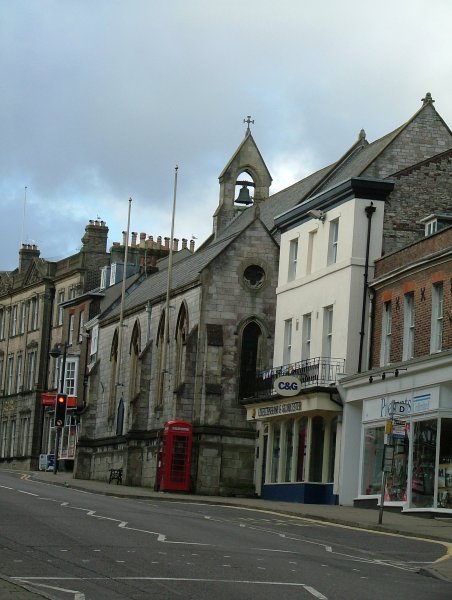 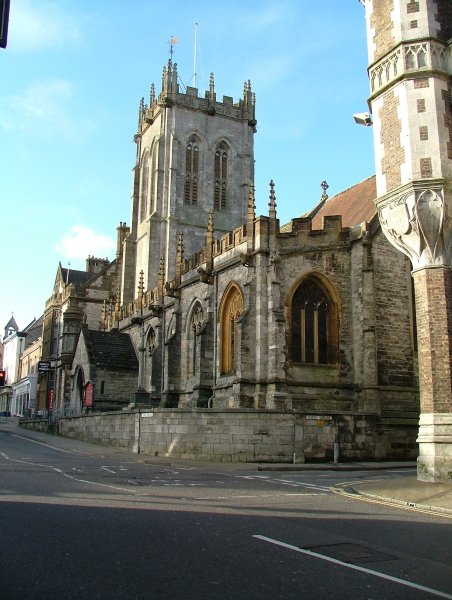 When in 1606 John the Patriarch was appointed Rector of Holy Trinity (picture left), Dorchester was one of the largest towns located on one of the busiest intersections in Dorset. Close to the church of Holy Trinity situated in Dorchester High Street is the largest church in Dorchester, St Peters (picture right). Although a distinct and independent parish church with its own parochial officers, it has been a chapel of Holy Trinity since at least the year 1303. As such John White in common with his predecessors became Rector of both the most prominent churches in Dorchester, which gave him a highly respected position of importance within the community. When in 1606 John the Patriarch was appointed Rector of Holy Trinity (picture left), Dorchester was one of the largest towns located on one of the busiest intersections in Dorset. Close to the church of Holy Trinity situated in Dorchester High Street is the largest church in Dorchester, St Peters (picture right). Although a distinct and independent parish church with its own parochial officers, it has been a chapel of Holy Trinity since at least the year 1303. As such John White in common with his predecessors became Rector of both the most prominent churches in Dorchester, which gave him a highly respected position of importance within the community. There is no doubt that he continued to preach, this time from his own pulpit, with as Wood put it, "great gravity and presence" and he quickly gained respect not only from the local community but the puritan movement as a whole. During the course of his Ministry which lasted over 43 years he is said to have expounded the whole of the scripture and to have gone through about half of it a second time. In William Whiteway's diary for example there is reference in January 1627 to "Mr White's morning lectures being increased from Mondays and Fridays to Mondays, Tuesdays and Fridays". The pulpit was also the place where people in the community first heard important items of news. It is clear from William Whiteway's diary that they kept very much in touch with, not only what was going on in London, but also the continent. The church therefore was right at the heart of the community and the next service might contain information on anything from the success or otherwise of battles, to decisions taken by the Corporation, judicial judgments, new Acts of parliament, births marriages or deaths of Royalty and important personages etc all with a comment from the Rector making it clear how he viewed these developments.
Funds raised to support the Hospital soon exceeded all requirements so in 1622, as there had been complaints about the quality of beer produced locally, it was decided to use the surplus in the erection of a Brew house 7 on spare land already purchased for the Hospital. This was so successful that it managed to underpin many of the charitable schemes they embarked upon. John White also saw to creating financial stability for the Clergy of Dorchester but did not forget the needs of others as Dorchester contributed to National appeals for aid to a far higher degree than most towns in the Country throughout his tenure there. 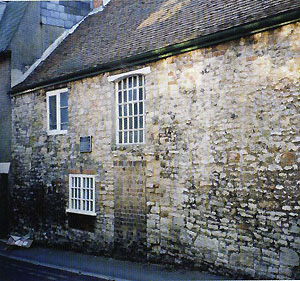
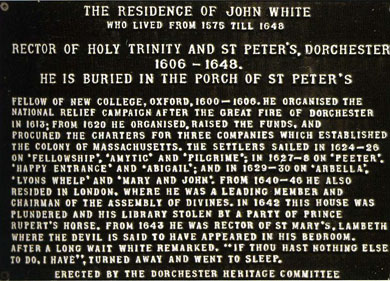
The four children John White listed in the Visitation of Hampshire which was taken in the year 1634 and who are also listed in Mary Terry's Will of 1637 were: as given below. (3 &23) It is also clear from the Will written in 1630 of Joan Gould the rich widow of James Gould that the Patriarch had at least some grandchildren and there may well have been more than those identified below. 1. John White [junior] (1607- 1678) He was actually baptised at Stockton Wiltshire on 27th December 1607 by John the Patriarch's brother in law John Terry who was rector there (36) . Educated at St Catharine's College Cambridge from 1631 he was awarded his BA in 1634/5 (recorded in the alumni under John Whyte) and his MA in 1638. He also took holy orders and his appointment to the living as rector of Pimperne in Dorset was approved by Parliament on 7th July 1646 although church records show his institution as rector to be 15th September that year(20) and his patron to be Rev Charles King. According to Rose-Troup he may also have served as curate in charge in Dorchester during his fathers absence in London. From 'Edmund Calamy's Account of Ministers and others ejected and silenced - 1660/2' it is clear that he was obliged to quit his living at Pimperne during the Restoration and he appears to have assisted Mr Lamb at Bere Regis 1662-1665 as Calamy refers to him in 1665 as living at the tithing of Holt in the parish of Wimborne Minster in Dorset and to be 'late curate of Beer'. This appears to tie up with the assessment of a 'Mr White' at Beer Regis for hearth tax (4 hearths) and then the appointment of Thomas Baskett as curate of Beer in 1665. Calamy's final reference is to him being licenced as a Presbyterian at Morden in Dorset on 8th May 1672 by which time he was already 65 years old. No record has so far been clearly identified of a marriage but it seems likely that the burial at Morden of Mr. John White on 2nd October 1678 is likely to be him when he would have been aged 71. 2. Samuel White ( - 1660) a goldsmith with a shop in Dorchester by 1640 and of sufficient stature within the community by that date for the Corporation to entrust repair of one of the Maces carried by Serjeants of the Mace at the ordination of the Mayor. He married twice. First to Sarah the daughter of Edward Cuttance of Weymouth by whom he had a daughter Hester who is listed in the 1634 visitation of Hampshire. By his second wife he had two children Anne and Samuel. As a Master Goldsmith in Dorchester he took on apprentices vizt: Elias Nichols the son of John Nichols from Bridport for 10 years on 21st Apr 1640, and John Bedford the son of John Bedford, on the 30th Dec 1658 for a period of 8 years. He may have died by 1661 as the town accounts show that payment for silver work commissioned on town maces was being made to 'Mr Samuel Whites wife'. 3. Josiah [Josias] White ( - 1674) a merchant of Dorchester and Rouen in France. He was left £10 in 1630 by his godfather John Gould the Elder (1588-1630) "to be paid to his father to his sons use" . He married Margery daughter of Nicholas Hallett of Bradpole by whom he had a son John before 1634. Josiah died in 1674 4. Nathaniel White ( - ) (18) He was unmarried in 1634 at the visitation when he is already described as a 'Captane'. He was certainly appointed executor of his fathers meager estate on 14th June 1649 and appears to have contracted heavy debts as a merchant. In 1647 £20 of his debts was left as a bequest in the will of Samuel Bushrod (the son of Richard Bushrod (1575-1628) to a destitute niece of Samuel's called Mary Whitefield. Nathaniel is said to have been in Captain Joyce's troup which hotly pursued Charles II after the battle of Worcester (3rd Sep 1651). Interestingly there is an entry in Dorchester records dated 13 Feb 1651/2 when he is referred to as Captain Nathaniel White and paid £3. 9s 1d the balance of his fathers account due from the Brewhouse. And "out of our respect to his father and family it is ordered that he shall have given to him the sum of £5 and more as a boone at his departure towards Garnsey" . This suggests that he left Dorchester after the Civil War. John White did not agree with the separatist movement believing that the church could be reformed from within. He saw immediately however the business and religious possibilities that New England represented and with his usual zeal set about exploiting it. John White felt that this could form the nucleus for a larger colony and a refuge for those persecuted for their religion, both from those wishing to leave the separatists at Plymouth and from England. They together with other like minded friends and traders came together to take the issue forward and the records of the Council for New England show that a licence to search for a site for a new plantation was granted on 18th February 1622/3. Support for the venture was clear as the Council ordered preparation of a letter giving reasons why western merchants should further the scheme of settlement and asked the King to send out copies to all the shires. A year later, on 18 February 1623, the council granted a patent to Sir Walter Earle, . The promoters, led by Earle and White, met in March 1624 at Dorchester to formally organize the venture. They formed the "Dorchester Company " which soon had 119 stockholders paying £25 per share. Altogether, the company's initial fund came to more than £3,000. Even before that meeting, the new Dorchester Company purchased a small ship of 50 tons called the Fellowship which set out for New England in the summer of 1623. It arrived too late for productive fishing and left fourteen men and provisions to occupy Cape Ann. Two additional voyages, in 1624 and 1625, also failed as fishing expeditions. The latter had to be financed on borrowed funds, resulting in great loss to the company. Sinking into debt with no obvious way to turn a profit quickly, the company folded in 1626. By that time about fifty men had been left at Cape Ann, and some men from Plymouth Colony who disliked Separatist rule (including John Lyford and Roger Conant) joined them. Their experience as colonists was useful to the plantation, yet the undertaking did not flourish. Cape Ann was twenty miles from the best fishing waters and had little agriculturally productive land. The site being unsuitable, Roger Conant advised all who wished to remain in New England to transfer to Nahum Keike, afterward named Salem. Despite the Dorchester Company's bankruptcy, John White undertook to provide the necessary supplies for the Nahum Keike colonists. The next ship 'The Abigail' (another Weymouth vessel) sailed on 20th June 1628 carrying the Plantations new Governor John Endecott and about forty other colonists for Nahum Keike. 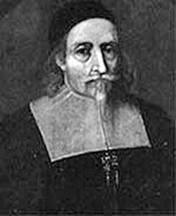 As soon as Endecott arrived in New England it was not long before he disclosed his domineering spirit. The old planters must have learned with intense surprise that they had been handed over, as Endecott represented, body and soul, with all their worldly goods, servants, fields and buildings to the new company. Endecott moved quickly appropriating their homes for the new settlers and even had the frame of their great house built for the Dorchester men dismantled and re-erected at Salem for his own use. As soon as Endecott arrived in New England it was not long before he disclosed his domineering spirit. The old planters must have learned with intense surprise that they had been handed over, as Endecott represented, body and soul, with all their worldly goods, servants, fields and buildings to the new company. Endecott moved quickly appropriating their homes for the new settlers and even had the frame of their great house built for the Dorchester men dismantled and re-erected at Salem for his own use. Confronted with a Governor who ignored all claims to any consideration for their efforts, which had actually provided a plantation for him to rule, they withdrew co-operation and considered leaving to another plantation at the bottom of the Bay. Facing a winter with no experienced planters Endecott was forced to concede to a few of their claims and to put their case to the Patentees in London. The old planters naturally turned to John White for his support and with his influence their grievances were eventually addressed by special grants of land etc. Roger Conant and others eventually moved to to a new location which in his life time became the town of Beverly. Their land grant however overlapped a number of other grants handed out by the council including that issued in 1622 to the Earl of Warwick, Lord Gorges, Sir Robert Mansell, and Sir Ferdinado Gorges. It was a complicated situation as the Earl of Warwick was the president of the Council for New England. Warwick was in sympathy with the puritans and seems to have been willing to help them out with getting the patent. Gorges, upset by the latest grant, declared that it was obtained from the Council in a clandestine manner during his absence at war with France. As might be expected this caused a good deal of anxiety about the security of the patent. 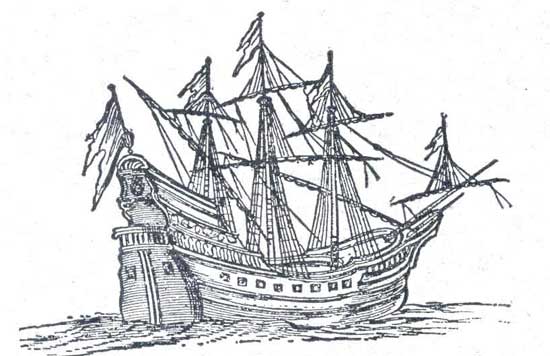 While the Massachusetts Bay Company was preparing for the sailing of what has become known as the Winthrop Fleet, White was preparing his own ship, the 'Mary and John', with another batch of planters from the west country areas. Many of the passengers were known or recruited personally by White or were his own relatives through marriage or blood. He does not appear to have been happy with all the developments and loss of influence within the new company as he instructed the master of the ship , Thomas Squibb a Weymouth man, "not to land them at Salem but to take them into the Charles River". It seems likely that most of those from Dorset and Somerset would have embarked at Weymouth, perhaps accompanied by John White himself for the short voyage down the coast to Plymouth where they picked up the remaining west country emigrants. There the Rev. John Warham and Rev. John Maverick were chosen to be their ministers in New England. In Plymouth John White would have been reacquainted with his intimate friend and preacher of Gods word there Matthias Nicholls. He certainly attended and spoke at the service there before their departure. While the Massachusetts Bay Company was preparing for the sailing of what has become known as the Winthrop Fleet, White was preparing his own ship, the 'Mary and John', with another batch of planters from the west country areas. Many of the passengers were known or recruited personally by White or were his own relatives through marriage or blood. He does not appear to have been happy with all the developments and loss of influence within the new company as he instructed the master of the ship , Thomas Squibb a Weymouth man, "not to land them at Salem but to take them into the Charles River". It seems likely that most of those from Dorset and Somerset would have embarked at Weymouth, perhaps accompanied by John White himself for the short voyage down the coast to Plymouth where they picked up the remaining west country emigrants. There the Rev. John Warham and Rev. John Maverick were chosen to be their ministers in New England. In Plymouth John White would have been reacquainted with his intimate friend and preacher of Gods word there Matthias Nicholls. He certainly attended and spoke at the service there before their departure.The brothers Ralph and William Sprague from Fordington who came over at their own expense on the 'Abigail' in 1628 were personal friends of John White. Their families had followed on the 'Lyons Whelp' arriving by 1629. Ralph and William were among those sent by John Endecott to stake out the claim on the Charles River and we find that in 1630 Ralph Sprague was of sufficient stature to be elected to sit on the first ever jury empanelled in Massachusetts. He was made constable of the newly named Charlestown the following year. It was to that town the emigrants made their way after they had been landed , contrary to orders at Nantasket; and there they began to erect a shelter for their goods, but not many days after they "had order to come away from that place". and they settled at Matapan which they called Dorchester in honour of their reverend friend John White. Had White intended to establish a plantation upon the several hundred acres to which he was entitled he would almost certainly have asked Sprague the pioneer who was ideally situated to select a site, and events would no doubt have followed much the course that they did. For a number of years following the migration he had intended to make the journey himself, but for some reason he never did(28). In 1631 he so energetically collected provisions needed in Massachusetts, that some people in Dorchester accused him of diverting parish funds to that cause. On 2nd February 1630/1 John WHITE was present as one of the witnesses to the signing of the Will of Mr William PERKINS a wealthy merchant of Dorchester who was subsequently buried at Holy Trinity Church on 25 Feb 1630/1. In his Will, William Perkins left 14 shillings to be distributed to the poor of Holy Trinity parish, and £100 to the Mayor, Bailiffs, Aldermen and Burgesses to be employed in such charitable purposes as John White and his executor (his father) directed. In the meantime the corporation sought a qualified replacement in the shape of the Rev Thomas Hill (c1600-1654) a scholar fellow and tutor of Emmanuel College Cambridge, but he refused a handsome offer of £100pa to come to assist John White. He decided to continue studies for his Bachelor of Divinity and in 1645 was to become Master of Trinity College and another Minister in Westminster's Assembly of Divines. Another Minister that stepped into the breach from the end of 1632 was Rev Jonathan Lawrence (1601-1664) as he is paid £10 out of the Seaton parsonage for 6 months assistance to John White on 19 April 1633. Jonathan was the son of William Lawrence from Winterborne Steepleton and went on to become rector of Haselbury Bryan and Upway. It was in that year (1633) that John White refused to read extracts from the "Book of Sports" as ordered by the Archbishop of England and an out spoken sermon caused him to come under suspicion of non-conformity. His personal study was searched for evidence against him but he seems to have escaped punishment. The Corporation continued with its efforts to appoint an assistant and after another abortive effort in July 1633 the Mayor and Burgesses agreed to appoint the Rev Hugh (Hugo) Thompson (1604-) to the post on 14 Mar 1633/4. He did not have quite the background renown they were looking for and tried to entice him with a £60pa stipend but in the end had to agree to the £100 previously offered to Thomas Hill. Little else is known about this time as proceeding were interrupted by the Civil War. Perhaps fortuitously John Whites name had been listed in an ordinance issued by Parliament on the 12th June 1643 'for the calling of an Assembly of Learned and Godly Divines, to be consulted with by the Parliament, for the settling of the Government of the Church' . The ordinance stated that 'all and every person named are to meet and assemble at Westminster in King Henry the VII's Chapel on 1st July 1643. Given the situation in Dorchester and the summons to Parliament there is little doubt that John White left Dorchester in June and in all probability was accompanied by his wife (37). This body became known as the 'Westminster Assembly of Divines' and according to Anthony Wood, John White was 'one of the most learned and moderate among them'. He was obviously well respected as he was appointed chairmen of one of the existing committees which on 22nd August 1643 sought the agreement of the Commons to six draft orders for the ejection of ministers beneficed in London and Hertfordshire, and their replacement by others who were regarded as godly men (10). He continued throughout this time to refer to himself as 'Mr White of Dorchester. In 1645 White was appointed to succeed the ejected Dr Featley as Rector for the parish of Savoy in Lambeth and the doctor's library was committed to his care 'until his own should be returned'. 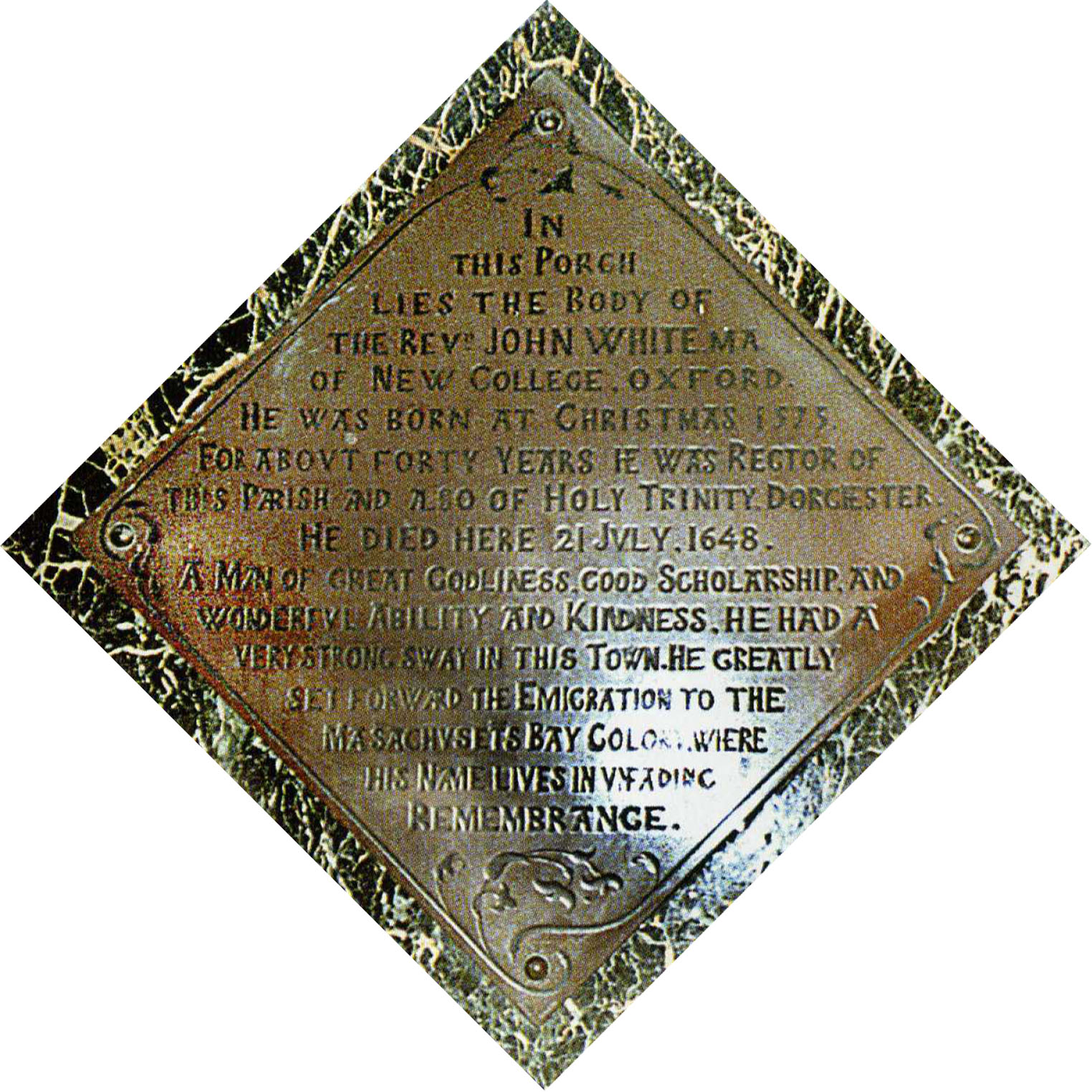 Memorial Plaque to Rev. John White © Picture Michael Russell FIPD June 2009 The Rev John White died suddenly on the 21st July 1648 and was buried three days later under the south porch of St. Peter's Church8 where the plaque above has been erected in his honour. Virtually destitute the corporation had to give his executor £5 to distribute to the poor in his name, and they had the porch 'hung with black at the funeral and for a month afterwards'. Genealogical Notes:- 1. Oxford University Alumni, 1500-1886. Before 1752 the year started on 25th March not 1st January. He was therefore baptised on 6th January 1574 but the correct transcription procedure is to use both Old and New Reckonings hence 1574/5 2. http://www.oxforduk.co.uk/historydetail.php?id=16131&f=Oxford. also its official grade 1 listing at - historicalengland.org.uk/listing/thelist-entry/1182305 - and entry in Victoria County History Volume 5 Bullingdon Hundred. Pages 282-293 3. Rose-Troup, FJ - John White , the Patriarch of Dorchester and founder of Massachusetts 1575-1648 - New York and London GP Putnam's sons Published 1930. In John WHITE the Patriarch's Pedigree recorded on pages 404-405 see his fathers sister (Avys) entry where here marriage settlement makes it clear that Doctor WHITE Warden of New College Oxford was her (and his fathers) uncle i.e. brother to Mark WHITE of Timsbury 4. Strype, Memorials of Archbishop Cranmer, II. p233 5. On her marriage (3 above) records that he wrote an Epithalamium 6. The Wordsworth Book of Kings and Queens of Britain pub 1997 by Wordsworth Editions Ltd 7. Water was undrinkable in most towns and villages at this time so most drank beer which was sterilized. The first mash which was strong was drunk by men, the second by women and the third, the weakest, by children. 8. The Last will and Testament of the Rev John WHITE has also been transcribed and can be viewed on this site 9. Rose-Troup refers on page 17 of her book to 4 daughters but then only lists three in the pedigree which was actually written by John White himself. This error is repeated in "Dorchester Divided" (14 below) in the Family Tree provided on page 187. In my view both stem from a miss reading of John Whites Will which I have transcribed ( 8 above) where he refers to four sisters. It needs to be appreciated that in the 17th century the spouse of a sibling was simply treated as a brother or sister and referred to as such see genealogical note 2 on his will. 10. Puritans in Conflict by John Trevor Cliffe 11. History of the Chancellorship of Oxford [1853 edition] page 117 12. National Archives Records of the Prerogative Court of Canterbury PROB 11/125. Can now (2014) be viewed on ancestry.com 13. Chalmers Biographical Dictionary 14. Dorchester Divided Researches & Reflections on Dorchester in the early 17th century by the Community Play research group published in 2002. Pages 185-196. 15. British History on Line - The Coat of Arms at the top of the page is that of John White of Southwick Hants a sketch and description of which can also be found in the Victoria County History for Hampshire John Whites pedigree is recorded in the Hampshire Visitation of 1634 which goes back to John White of Timsbury where he claims descent from a younger brother of White of Southwick. The Harleian Society 'Pedigrees from the visitation of Hampshire ' a compilation up to 1634 was published in 1913 and shows the coat of Arms on page 229 with the pedigree extending onto the following page and can be seen via this link. 16. Victoria County History of Oxford Volume 5 pages 282 - 293 17. Re Thomas White (Whyte or Whight) (1514-1588) There is some confusion between the many Thomas Whites in the Oxford University Alumni 1500-1714. For example (page 1616) it quotes his also being Rector of Bishopstoke Hants in 1545. The Church of England Database (CCED) (http://www.theclergydatabase.org.uk/jsp/locations/index.jsp) confirms the appointment of a Thomas White on 20 Oct 1545 but also his natural death in 1551 when he was replaced by a John Bale. 18. Re Nathaniel White. Rose Troup refers to his being unmarried in 1634 but the ref quoted from the Municipal Record of Dorchester by CH Mayo published in 1908 (i.e.page 466) is incorrect as it refers to his brother Samuel for a different year. He is however mentioned in the MRD See :- Page 371: Charter 689 dated 14 Dec 1647 released him of debts owed to George Cole merchant of Dorchester & is witnessed by John Bushrod and his 2 brothers Samuel & Josiah. Also Charter 690 dated 17 Dec 1647 which released him of debts owed to George Little merchant of Toller Porcorum. Page 603 date 24 July 1648, empowered him to receive all tithes due to his father until the appointment of a successor, and to have the lease for his fathers barne 'enlarged'. Page 604:- The mayor ordered the corporation to pay £5 to him to give to the poor in Mr White's name. 19. The Municipal records of Dorchester has ref to John White (page 594) with a footnote with a few notes on his degrees at Oxford etc it includes ref to his being Vicar of Fering in 1605. I have looked this up in the Church of England database and it refers to a collation record dated 17 May 1605 in the Guildhall Library in London (Register 9531/14) of a Johannes (i.e. Latin for John) White BA Deacon being made perpetual Vicar of Feringe in Essex - his patron was Richard Bishop of London. Their records however refer to him getting his MA 25 Nov 1607 and we know the Patriarch had his MA in 1600/1 so this does not refer to the same John White. 20. CCED - The Clergy of the Church of England database (CCEd) is an online database of clergy of the Church of England between 1540 and 1835. [Entries under Thomas Whyte and Johannes Whyte] 21. Municipal Records of Dorchester pages 594-603 22. Stephen M. Lawson http://kinnexions.com/ancestries/terry.htm [also note John Terry's name can be spelt in lots of different ways. Apart from Johannes the latin version of John I have come across 'Tirrie' : Terrie : and Tyrrye.] (see also DNB) 23. Visitation of Hampshire 1634 page 229 written by John White. See also introduction page vi states " Pedigree & Armes of White at Dorchester, as attested by William Ryley Lancaster". 24. John WHITE signed the parish Register for Holy Trinity between 20th July and 1st August 1606 25. Source CLDS Extraction programme from the Parish Registers for Hornchurch in Essex 1576-1812 Film number 571181 batch C04272-1 26. Speculation in America that William WHITE (b.1617) went to New England to live with his family stems directly from the Will of his brother James White of Barbados (1621-1666) PRO 11/326. Benjamin Gillam and Arthur Mason were William Harris's grantor in New England in November 1665 and are listed as creditors in September 1666 in Captain James White's will. It was probably Captain White's brother William who witnessed William Harris's 1677 deed in Boston. The Captain's will, drawn in Boston in September 1666, gave bequests to children of "my well beloved brother, William White, late of London, in Old England", and made him one of six executors, but he desired 'them to follow the advise of my said brother William' who was guardian of the main beneficiary, his son and Captain James White's nephew. He also added a codicil to the Will on being advised of his brothers loss in the great fire of London and that he had invited him, his wife and children to come to New England. If he did not come over his other executors were to take charge of his affairs. We know from the National Archives that William had the will approved in the Strand in London but not until 11th February 1668. This is almost certainly because he had to travel to New England to collect the documentation and organise James affairs which were far from straightforward as he left a wife and plantation in Barbados. Its clear William White lost his house and all his possessions in the great fire and that his salvation lay in managing the estate entailed to his sons Josias and James, the latter being his brothers heir, so there was certainly a huge driver to emigrate. He is thought to be the William White who took the oath of allegiance at Boston in April 1679 (BRC,29:169), and the merchant returning from London in Oct 1681 with power to act as John Rawlinson's attorney (Coldham, The Complete Book of Emigrants, 1661-1699 - note 44 - 385), also the merchant who signed a bond for William Harris's estate in 1684, and the merchant of Boston granted a letter of attorney by Nathaniel Newgate of London in April 1686 (Suffolk Deeds - note 13 - 14:18). As his brothers executor he would be associated with James creditors Arthur Mason and Benjamin Gillam, and with the merchant William Harris. Capt White's Will also revoked 'ye will and bonds left with John Harris, to give to Mr Job Browne at my coming from Barbados last' and left Harris three thousand pounds of sugar. 27. I obtained this image in 2008 when carrying out a lot of research into his life but any notes that I took then have now been lost. I have always understood that it is a woodcut depicting him during his period on the Assembly of Divines 1643-1646 and it probably originates from early publications about the Assembly. In 2012 I carried out another search for its original source at the request of Kate Hebditch a consultant to the Dorchester Heritage Committee but apart from locating its use on other sites could not pin down its original source. It has now 2013 turned up on the National Portrait Gallery website so I have provided a link from which it can be seen that the original also contains additional text that I was unaware of in 2009 when I wrote the account. 28. The following letter from Govenor Winthrop to the Rev. John WHITE, Rector of Holy Trinity and St Peters Dorchester, Dorset,M is printed at pp.126 and 127 of the Proceedings of the Massachusetts Historical Society, 1860-2. Reverend and Worthye Sir, 29. This is confirmed by the pedigree written by Rev John White in the 1634 Visitation of Hampshire page 230 which was published and attested to by William Ryley Esq of Lancaster a Herald at Arms and published in 1903. The Manor of Little Bourton was purchased by Thomas GARDNER of London from William & Catherine MATHEWE in the year 1565 (See link provided to British History On-Line - From: 'Parishes: Great and Little Bourton', A History of the County of Oxford: Volume 10: Banbury hundred (1972), pp. 175-184.). This seems very early to be our Thomas Gardner unless he was considerably older than Elizabeth White who according to Rose Troup (page 393) is unlikely to have been born before 1582. Elizabeth's husband was probably therefore his eldest son named after him. We know from Thomas Gardner's will that his eldest son Josiah inherited the Manor in 1633 but Josiah went to the West Indies in 1650. British History also gives a reference for Josiah in 1648 as O.R.O., Misc. Pe.V/3 which might be worth further research. The Manor appears to have remained in the Gardner Family however until sold to Thomas Wyatt of Cropredy in 1716 (Ref Ibid. Pe V/10; Bodl. MS. Ch. Oxon. 2658) 30. The Will of John White of Stanton St John dated 30th Sep 1616 (proved 26th Sept 1618) see Oxford Wills series II Vol 4 page 224d - and rough transcription given in Rouse Troup's biography of John White page 411 31. The Will of Stephen White of Stanton St John dated 7 Nov 1629 Proved 15 Feb 1629/30 (Stephen White Gentleman of Stanton St John P.C.C.13 Scroope) - and a rough transcription given in Rouse Troup's biography of John White page 415 32. Martha White: Marriage details source - Wiltshire Registers of Marriages, 1538-1812 Parish of Stockton Wiltshire. 'William Cooke, clerk, & Martha White, of Stanton St. John 27 Apr 1597'. Also Rev John White's pedigree submitted by himself recorded at the Hampshire Visitation which was completed prior to 1634 and shows she married William Cooke of Straton. William Cooke's Will at PCC Ref PROB 11/125 and can be viewed by members on ancestry.com. Ref to he son Nathaniel Cook being usher at the free school in Dorchester is in William Whiteway's diary. 33. The baptisms of Elizabeth and Martha WALTON are also recorded in the Court Files Essex County under Marblehead in America Quarterly Court Volume 1 page 69 as being from Seaton in Devon in England 34. Sources quoted in America are:- Russell, Gurdon Wadsworth. An Account of some of the descendants of John Russell, the emigrant. Lockwood & Brainard Co Hartford Connecticut 1910. Robert Charles Anderson The Great Migration Begins:Immigrants to New England 1620-1633 Volls 1-111 Boston 1995 Black Harrison. The Ancestry of Frances Maria Goodman (1829-1912) by Harerison Black Boston 2001. 35. John WHITE Junior (1607-1678) His baptism:- Rose Troup (3 above) Page 24 ; Appointment to Pimperne CCED see GN 20 above and comments re Calamy revised ; 36. Image now available on ancestry.com of Stockton Parish Register where it records "Johes White, filius Johis White Clerk, Rector of Dorchester in Com Dorset natus vicesimo primo, baptizatus fuit 27o Decembris". [John White son of John White Clerk, Rector of Dorchester born 21st, baptised 27th December ] 37. We know very little about John White's wife Anne nee Burgess. There is no trace of her burial in Dorchester and the only references I have found to her are in three Wills. She is left a gold memorial ring in the Will of the rich widow Joan Gould in 1630. Joan Gould also made bequests in the same Will to Rev John White her husband , their grandchildren and some of his many schemes designed to promote a godly community. Rev John White was also named as one of the overseers of Joan Gould's Will along with their friend William Whiteway the elder. Anne is also also mentioned in the Wills of her brother John Burgess in 1634 and that of her sister-in-law Mary Terry who died in 1637. Given the serious situation in Dorchester at this time John White would not have left his wife behind when summoned to Parliament and it is reasonable to suppose therefore that she went with him when he left Dorchester in June 1643. There is equally no evidence that she ever returned to Dorchester and indeed her death, coupled with his increasing poverty and age are probably what occasioned his return to Dorchester in 1646. 38. Thomas Whyte (1514-188) was replaced as Rector of Stanton St John on 12 May 1574 by Martinus Cullpepper who served there until 3 Mar 1601 when he became dean of Chichester (Source: CCED off line for maintenance as at July 2019) 39. Information about the Manor of Stanton St John was originally taken from Rose Troup's publication in 1930 (See genealogical note 3 above) about the Life of Rev John White. On page 17 she states when referring to Dr Thomas White of New College "his nephew, John White, in 1561, was granted a lease of the 'suite and demesne lands of the manor of Stanton St John,' a college estate. The living of this parish was held according to custom, by the Warden of New College pro tempore so at times Dr. White would have lived in the old rectory, now destroyed, which stood immediately south of the church". |
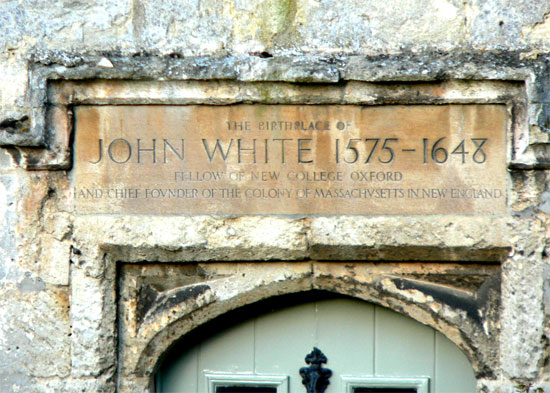 Rectory Farm House: John the Patriarch of Dorchester therefore grew up with his two brothers and three sisters in this impressive two storey farm house with its high attics and fine stone mullion windows. It's grade II listing confirms that it was built late 16th, early 17th century of limestone ashlar and rubble with a concrete plain tile roof. The picture above shows only the front of the farm but it's L-Plan can be better appreciated in the map of the Manor shown above the picture. The Patriarch is commemorated in an inscription above the front door (picture right) which states 'The birthplace of John White, 1575-1648, Fellow of New College, Oxford, and chief founder of the colony of Massachusetts, New England.' Rectory Farm has been providing food continuously for the inhabitants of Oxford for nearly 500 years so John White and his siblings would have been familiar with the daily bustle of a working tenant farm.
Rectory Farm House: John the Patriarch of Dorchester therefore grew up with his two brothers and three sisters in this impressive two storey farm house with its high attics and fine stone mullion windows. It's grade II listing confirms that it was built late 16th, early 17th century of limestone ashlar and rubble with a concrete plain tile roof. The picture above shows only the front of the farm but it's L-Plan can be better appreciated in the map of the Manor shown above the picture. The Patriarch is commemorated in an inscription above the front door (picture right) which states 'The birthplace of John White, 1575-1648, Fellow of New College, Oxford, and chief founder of the colony of Massachusetts, New England.' Rectory Farm has been providing food continuously for the inhabitants of Oxford for nearly 500 years so John White and his siblings would have been familiar with the daily bustle of a working tenant farm.